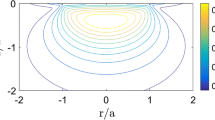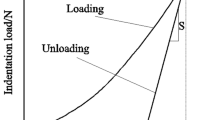Abstract
Analysis of ball-indentation process was made by the finite element (FE) method. A series of indentation FE analyses were made on materials with different elastic modulus (E), and a simple relationship between E and the load-depth (F-h) unloading data is presented. In order to check for the influence of other material properties, thorough research has been performed, introducing a combination of response surface (RS) and FE analysis. As a result, a relationship between the indentation unloading slope, E, and the strain hardening exponent was derived. Also, the indenter compliance effect has been investigated. The indenter compliance correction was calculated and applied to the experimentally measured F-h results. Experimental testing was made on three materials with essentially different elastic moduli. Comparison of the results obtained by newly developed equations with the results from other well-known equations is also presented.
Similar content being viewed by others
References
H. Hertz, Miscellaneous Papers by H. Hertz, edited by Jones and Schott (Macmillan, London, 1896).
D. Tabor, The Hardness of Metals (Clarendon Press, Oxford, 1951).
I. N. Sneddon, Int. J. Eng. Sci. 3, 47–57 (1965).
I. N. Sneddon, Proc. Cambridge Philos. Soc. 42, 29 (1946).
I. N. Sneddon, Proc. Cambridge Philos. Soc. 44, 429 (1948).
G. M. Pharr, W. C. Oliver, and F. R. Brotzen, J. Mater. Res. 7, 613–617 (1992).
W. C. Oliver and G. M. Pharr, J. Mater. Res. 7, 1564–1583 (1992).
H. A. Francis, Trans. ASME, J. Eng. Mater. Technol., 272–281 (July 1976).
A. K. Bhattacharya and W. D. Nix, Int. J. Solids Structures 27 (8), 1047–1058 (1991).
A. E. Giannakopoulos, P. L. Larson, and R. Vestergaard, Int. J. Solids Structures 31 (19), 2679–2708 (1994).
B. Taljat, Determining Stress-Strain Curves of Metals by Nondestructive Continuous Ball-Indentation Method, Ph.D. Thesis, University of Ljubljana, Slovenia.
S. P. Timoshenko and J. N. Goodier, Theory of Elasticity, 3rd ed. (McGraw-Hill, New York, 1970).
R. H. Myers, Response Surface Methodology (Allyn and Bacon Inc., Boston, New York, 1971).
Author information
Authors and Affiliations
Rights and permissions
About this article
Cite this article
Taljat, B., Zacharia, T. & Haggag, F.M. Analysis of ball-indentation load-depth data: Part I. Determining elastic modulus. Journal of Materials Research 12, 965–974 (1997). https://doi.org/10.1557/JMR.1997.0137
Received:
Accepted:
Published:
Issue Date:
DOI: https://doi.org/10.1557/JMR.1997.0137




